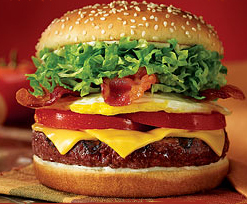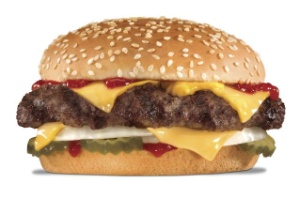How do great burger brands engender such fierce brand loyalty? I mean, think about it…there is no more crowded, cannibalized or mature segment in our industry, and yet the stars manage to keep shining and the raving fans keep raving…even on national TV.
How do they do it? As I look at the competitive field, there are a lot of branding lessons to be learned from the humble hamburger:
There are brands that have never taken their eye off the ball.
 ♦ In addition to some obvious examples from quick service like Carl’s Jr., In-N-Out and McDonald’s, I would add Red Robin in the full service category. They’ve avoided the menu proliferation that took some ’70s fern bars away from the core of their brands. Interestingly, when you click on their website menu, it opens to Classic Gourmet Burgers. You can click on a tab to see Other Delicious Items, but the unabashed focus is on burgers to the point that burgers outnumber entrees. They’ve even branded their originals: the Royal Red Robin Burger with a fried egg on top, the Banzai Burger topped with grilled pineapple and the Burnin’ Love Burger with crispy jalapeno rings.
♦ In addition to some obvious examples from quick service like Carl’s Jr., In-N-Out and McDonald’s, I would add Red Robin in the full service category. They’ve avoided the menu proliferation that took some ’70s fern bars away from the core of their brands. Interestingly, when you click on their website menu, it opens to Classic Gourmet Burgers. You can click on a tab to see Other Delicious Items, but the unabashed focus is on burgers to the point that burgers outnumber entrees. They’ve even branded their originals: the Royal Red Robin Burger with a fried egg on top, the Banzai Burger topped with grilled pineapple and the Burnin’ Love Burger with crispy jalapeno rings.
♦ Clearly this focus has paid off: They were named the Best Burger in the Full-Service Chain category by the 2009 Zagat Fast-Food Survey.
There are brands that managed to get their “mojoâ€Â back.
♦ In the late 1990s, Chili’s realized that they had drifted away from executing great burgers and called in the Lettuce Entertainment Group to reset their focus. They got their magic back by what I call strategy-driven execution. They got the right product and then they got the product right.
♦ They paid more attention to what they were selling–the buns, the cooking procedure, the ingredients and the presentation–and, more importantly, they branded it identifying a point of differentiation and naming it the “Big Mouth Burger†despite the fact that it really wasn’t necessarily bigger…it just looked bigger in the new shallower basket.
There are brands that discovered their inner “whopper.â€
 ♦ In the late 1990s, Carl’s discovered its point of differentiation: The gourmet-style $6 burgers were messy to eat. I’ll never forget the first time I saw the “If it doesn’t get all over the place, it doesn’t belong in your face†campaign featuring well-dressed young women dousing their clothing with dripping ingredients (later evolving into the notorious Paris Hilton ads). I was a little too hung up on my dry cleaning bills to be drawn in by this one, but then I wasn’t the target audience either. (I think they might have been going after young men.)
♦ In the late 1990s, Carl’s discovered its point of differentiation: The gourmet-style $6 burgers were messy to eat. I’ll never forget the first time I saw the “If it doesn’t get all over the place, it doesn’t belong in your face†campaign featuring well-dressed young women dousing their clothing with dripping ingredients (later evolving into the notorious Paris Hilton ads). I was a little too hung up on my dry cleaning bills to be drawn in by this one, but then I wasn’t the target audience either. (I think they might have been going after young men.)
And finally, there are brands that highlight the difference in a uniquely compelling way.
♦ There is no better example than the unpretentiously craveable slider from White Castle.
♦ It’s that time of the year again–Valentine’s Day. What better way to celebrate burger love? Every year, White Castles all over the country feature their tongue-in-cheek Valentine’s Day promotion…and no, it’s not too late to make a reservation for your candlelit dinner for two–â€a vase of flowers, a bag of sliders and thou.â€
The current surge of new chef-driven burger brands is built on the culinary heritage and legacy of success of many iconic brands: Create a point of difference that aligns to what consumers embrace, be true to your brand, focus like a laser on strategy-driven execution and never look back.
Until next time…I’d love to hear your thoughts.
